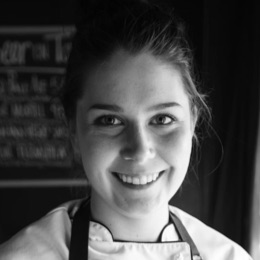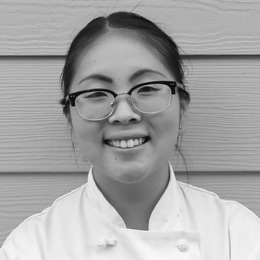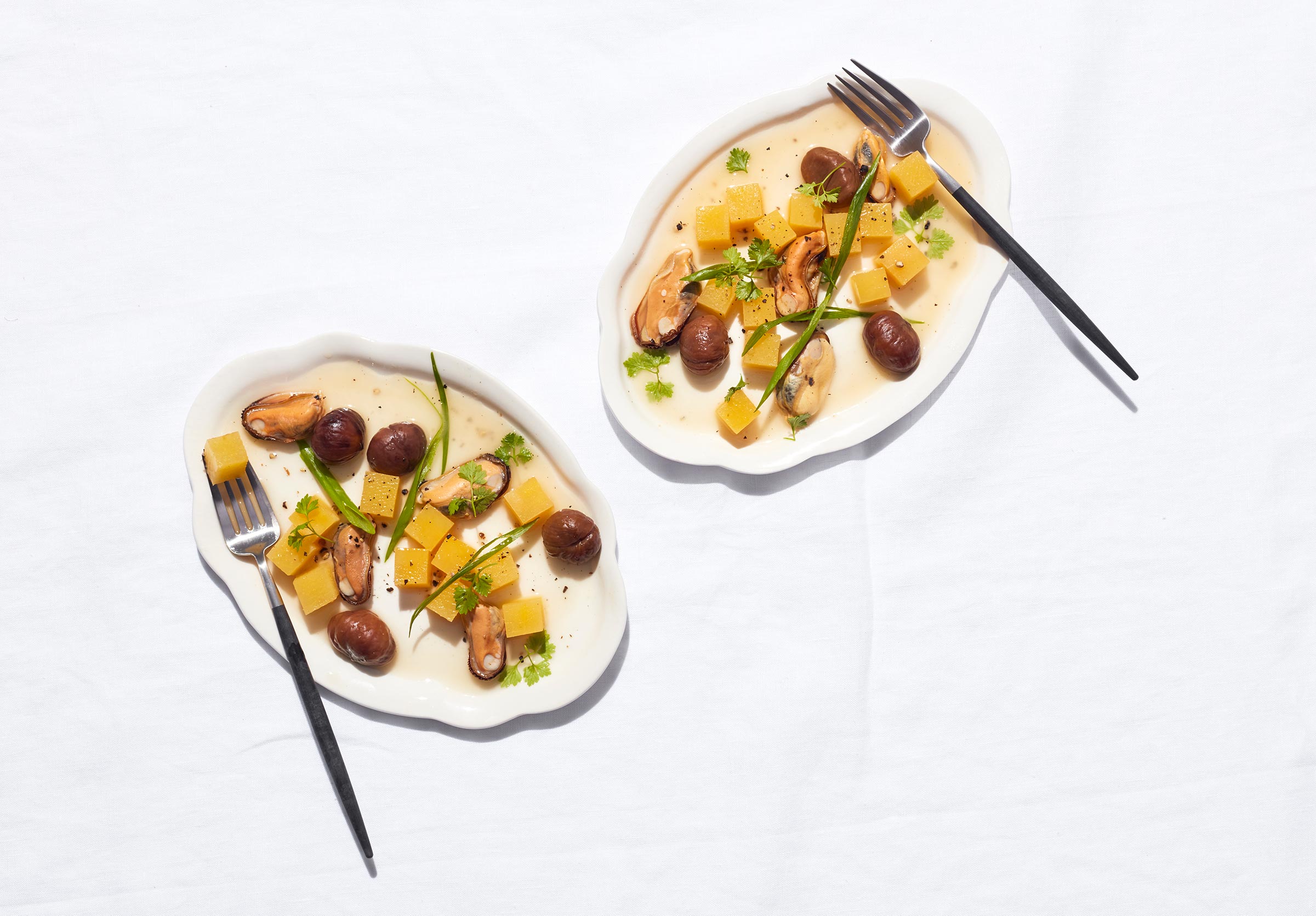
Whether inspiring others in the community to get comfortable in the kitchen or cooking multicourse meals for international dignitaries, these are Canada’s next star chefs. To celebrate their talent, we asked each to provide a recipe that shows off the ingredients and food traditions of their province or territory. Get to know these names, and enjoy their creativity in your own home.

Beet Greens Pesto

Ayla Smith
YukonBorn and raised in the Yukon, chef Ayla Smith grew up fishing, foraging and gardening. She has now transformed a tiny space in a small 1930s log cabin in Whitehorse into the kitchen component of Woodcutter’s Blanket, a hip cocktail bar where the 26-year-old shines a spotlight on local ingredients and techniques in an effort to evolve the territory’s culinary scene. Smith’s versatile pesto recipe makes use of beet tops and is delicious served over locally fished halibut or other meaty whitefish.
View recipe
Beet Greens Pesto
DIRECTIONS:
In the bowl of a food processor, combine all the ingredients except the olive oil and blend until a paste forms. Slowly add the olive oil through the feed tube, while the processor is running, until you have a saucy pesto. Adjust seasonings and add to salads, pastas, meats or fish.

Great Slave Lake Whitefish Smoked Chowder

Etienne Croteau
Northwest TerritoriesHaving studied cooking, gastronomy, anthropology and environmental science, Québec-raised chef Etienne Croteau, 38, combined a passion for travel, culture and exploration of new flavours by opening the Flavour Trader/Saveurs de l’Artisan, a café and spice shop offering cooking classes, farmer’s market meals and catering services. This month, Croteau will also take over a new restaurant space in the Prince of Wales Northern Heritage Centre in downtown Yellowknife. His multifaceted endeavour illustrates the evolution of the Northwest Territories’ culinary scene, which celebrates local fish and game while embracing global dishes and a broader range of ingredients.
View recipeGreat Slave Lake Whitefish Smoked Chowder
DIRECTIONS:
In a deep skillet or Dutch oven, melt the butter over medium heat and sauté the onion for 2 minutes. Add the remaining vegetables and cook for 5 minutes.
Sprinkle the flour and paprika over the vegetables, stir well and cook for another 1-2 minutes. Stir in the chicken stock, bring to a simmer and cook for 30 minutes. Add the fish, cover and cook for 5 minutes, until the fish is opaque; stir in the cream and season with salt and pepper.
Make a quick pesto by blending the cilantro, garlic, lime juice and olive oil by hand or in a food processor. For the crouton, cut the baguette into slices. On each slice, put a piece of Gruyère cheese and roast until they are golden. Serve the chowder topped with the cilantro pesto and a Gruyère crouton.

Okanagan Peach Cheesecake with Okanagan Spirits BRBN (Bourbon-style Corn Whisky)

Tina Tang
British ColumbiaBased at Predator Ridge Golf Resort in Vernon, B.C., Tina Tang, 24, supports young chefs through her involvement with the Okanagan Chefs Association and non-profit Canadian Culinary Federation (where she sits on the national board as junior liaison, helping unite chefs across Canada through networking and education). A supportive chef community is important to Tang, who feels everyone in the kitchen can learn from shared experiences, particularly in an industry driven by passion and creativity. The talented pastry chef will also compete at the IKA Culinary Olympics in Stuttgart, Germany, with Culinary Team British Columbia. In her pastries and desserts, Tang likes to showcase the stone fruits the Okanagan valley is known for. For instance, the purée in this cheesecake, she says, is perfect for imperfect fruits that are still worth placing on a pedestal.
View recipeOkanagan Peach Cheesecake with Okanagan Spirits BRBN (Bourbon-style Corn Whisky)
DIRECTIONS:
Preheat your oven to 350 F.
Spray a 9-inch springform pan with non-stick spray, then line the bottom (on the outside) with a generous piece of aluminum foil, wrapping it up around the sides with about 3 inches extra above the pan to keep water from sneaking into the cake.
To make the crust, combine the graham crumbs and butter and press into the bottom of the pan. Bake for 10-12 minutes, until pale golden. Set aside to cool and reduce the oven temperature to 325 F.
In a blender, combine the cream cheese, sugar, eggs, peach purée and bourbon and blend until you have a smooth and silky mixture. Pour over the cooled base, place in a larger baking dish that can accommodate the pan and 1 inch of water. Pour 1 inch of hot water into the pan and carefully transfer the whole thing to the oven.
Bake for 45-60 minutes, until the cheesecake is set, but still slightly jiggly in the middle. Cool and refrigerate for a day before enjoying.

Woods Chili

Sharlet Allan
AlbertaAt 18, Sharlet Allan has already overcome obstacles to graduate from and earn the role of peer leader of the Wood’s Homes Youth Culinary Arts Program in Calgary, a free training program that prepares at-risk and homeless youth for employment in the culinary industry. Having mastered dishes ranging from bannock to French pastries, Allan aspires to pursue her education at Southern Alberta Institute of Technology’s culinary arts program, while continuing to welcome, guide and mentor those who join the kitchen struggling to find their place in life. Allan’s cooking style reflects her learning at YCAP. A pot of nourishing Alberta beef chili exemplifies her contribution to the culinary community – it brings people together, she says, which reflects her way of being a chef.
View recipe
Woods Chili
DIRECTIONS:
In a large pot or Dutch oven, cook the ground beef, breaking it up with a spoon. Transfer to a bowl, draining off any fat, and add the oil to the pot. Cook the onion, pepper and jalapenos for 4-6 minutes, until soft. Add the garlic, cilantro, chili powder, cumin, coriander, paprika, cayenne, chili flakes, salt and pepper and cook for another 2 minutes. Return the meat to the pot and add the beans, tomato sauce, diced tomatoes and chicken stock, bring to a simmer, then reduce the heat and cook for 30 minutes.
Finish with lime juice and cilantro, adjust seasoning and serve.

Mushrooms with Melty Cheese & Grilled Bread

Beth Rogers and Thayne Robstad
SaskatchewanAfter a decade spent in Vancouver and Toronto kitchens, chefs Beth Rogers, 31, and Thayne Robstad, 32, returned to their hometown of Saskatoon to open Hearth, a 50-seat neighbourhood gem that they call their love letter to Saskatchewan. The menu leans heavily on the wild and cultivated edible bounty of their home province, prepared with modern techniques and an eye toward local tradition. With a fast growing population – and one of the youngest of any Canadian city – Saskatoon has a culinary scene propelled by these energetic chefs, who are redefining Prairie cuisine in a thoughtful, unpretentious way. Rogers and Robstad serve this dip at Hearth to showcase the bounty of Saskatchewan wild mushrooms – at the restaurant they use a mix of cultivated and wild varieties, and garnish the dish with an edible moss that grows alongside wild mushrooms in their northern boreal forest.
View recipe
Mushrooms with Melty Cheese & Grilled Bread
DIRECTIONS:
To make the mornay sauce, heat the milk to a bare simmer and set aside. In a heavy saucepan, melt the butter over low heat. Whisk in the flour and cook over medium heat for 90 seconds, stirring often. The mixture should look a bit like wet sand. Whisk in the warmed milk in 4 equal parts, making sure to whisk well after each addition.
Once the milk has been incorporated, ditch the whisk and find yourself a good wooden spoon. Stand over your sauce, stirring often with that wooden spoon until bubbles begin to form throughout. Remove from the heat and stir in the grated cheese. Add salt to taste.
Set a heavy frying pan over high heat and add your mushrooms and butter. Cook the mushrooms until nicely browned, reduce heat to medium and add the garlic. Toss the pan a few times and throw in your white wine to stop the garlic from burning. Reduce the white wine down by three quarters, stir in the parsley and another thumbnail-sized knob of butter for good measure. Salt to your taste.
Find some good quality bread and grill, toast or roast it. To assemble, pour the mornay sauce into a shallow vessel. Set your beautiful mushrooms on top. Serve immediately with the warm bread.

Blueberry Bison Meatballs with Manitoba Wild Rice

Christa Bruneau-Guenther
ManitobaChrista Bruneau-Guenther’s desire to reconnect with and share her Peguis First Nation culture through food inspired her to open Feast Cafe Bistro in Winnipeg, where the 41-year-old serves modern dishes rooted in First Nations culinary traditions. She works closely with community organizations to provide job opportunities and mentorship for those with barriers to employment, and plans to expand her café to include a cooking studio with classes and resources to teach traditional gardening and food preparation to all ages. Manitoba-raised bison features prominently on the menu at Feast, a tribute to its connection to the province and significance to Prairie Indigenous communities.
View recipe
Blueberry Bison Meatballs with Manitoba Wild Rice
DIRECTIONS:
In a large bowl, combine the ground bison, onion, breadcrumbs, milk, egg, garlic, salt and pepper, mixing well with your hands. Do not over mix. Roll the mixture into 1-inch balls.
Preheat oven to 375 F. Heat an oven-proof pan or Dutch oven over medium-high heat, add the olive oil and cook the meatballs, turning often, for 3 minutes.
Place the diced onion on top the meatballs. In a small bowl, stir together the jam, water and blueberries and pour over the meatballs. Cover and bake for 35-40 minutes, or until the meatballs are cooked through and the sauce has thickened.
Meanwhile, cook the wild rice as you would pasta. Fill a large pot with water, add pinch of salt, bring it to a boil and cook rice until each grain starts to split open and is al dente, 30-40 minutes. Serve the meatballs and sauce over cooked wild rice.

Arctic Char Gravlax

Joseph Szakacs
NunavutSince moving to Iqaluit, Joseph Szakacs, 43, has cooked at the Frobisher Inn, Water’s Edge Seafood and Steakhouse and the Qayuqtuvik Food Centre, where they addressed crisis-level issues of food insecurity among Inuit communities by providing free meals to anyone in need. Now, the chef/owner has recently opened Black Heart Café, Iqaluit’s first cappuccino-based coffee joint. Szakacs focuses on casual dishes made with locally sourced ingredients that draw people into this new community gathering place. When he cures Arctic char for their café menu and catering offerings, paying tribute to the more traditional air-dried Inuit version, pipsi, he adds a unique tea made with butterfly pea flowers. As the fish cures and moisture is drawn out, the flower’s blue pigment stains the flesh of the fish.
View recipeArctic Char Gravlax
DIRECTIONS:
Trim the char fillets and ensure the pin bones are removed.
In a non-reactive bowl combine the salt, sugars, pepper and tea, gently crushing the tea with your fingers.
With the fillet(s) lying skin side down, generously sprinkle the surface of the char with the mixture. Gently rub into the fish.
Sprinkle with the lemon juice and sandwich the fillets flesh to flesh, placing the dill in-between. Wrap the cure-packed fish in cheesecloth and allow to cure in the fridge for 32 hours, turning over every 8 hours.
Remove the fish from the cure and wash well in cold water. Dry well and reserve, discarding the cure. Serve thinly sliced with bagels or as an hors d’oeuvre.

Fresh Goat Milk Custard with Farm Fruit

Daniel Hadida and Eric Robertson
OntarioChefs Hadida, 30, and Robertson, 32, are the phenoms behind the Restaurant at Pearl Morissette in Lincoln, Ont. In the year since they opened, the ambitious kitchen has proven itself a vanguard of new Canadian dining, so much so it grabbed the top spot on Air Canada's Best New Restaurants list for 2018. Their mandate of locality and seasonality is not only evident in this dish, but also drives a robust preservation program and on-site garden, the latter tended by the restaurant’s renowned gardener and forager, Deirdre Fraser. With one Outstanding in the Field event and two Michelin on the Road dinners (collaborations with Chicago’s Elske Restaurant and Kadeau in Copenhagen), the world is evidently at their doorstep, and with good reason.
View recipeFresh Goat Milk Custard with Farm Fruit
DIRECTIONS:
Start by preparing the goat curd. In a heavy-bottomed saucepan, bring milk to 90 F. Remove from heat, add salt and buttermilk and stir. Pour into glass, heat-proof container, ideally half-filled. Cover and lay on side in warm room (73 F minimum) for 12 to 30 hours until milk has clabbered (clumps into a jelly-like substance). A sealed Mason jar works well here. Milk should have a nutty aroma. Drain milk through fine cheesecloth and hang in fridge for 2 to 3 days with a bowl underneath to catch liquid. Discard whey.
To make the custards, combine cream, ¼ cup sugar, eggs and egg yolk and cook to 175 F over a double boiler. Bloom gelatin in a bowl of cold water and incorporate into warm egg mixture (anglaise). Pass liquid through fine sieve twice to ensure no lumps. Blend in sour cream and fresh goat curd. Allow to cool to room temperature and season with cider vinegar. Pour into moulds and freeze until firm.
Cook the remaining sugar until a deep brown caramel, do not allow scorch, or it will become bitter. Cook the plums down separately until their juices have thickened. Purée until very smooth. Blend half of the jam into the cooled caramel.
To plate, remove goat custard from freezer 20 minutes prior to serving. Thinly slice fig and reserved plum. Pour one teaspoon of plum caramel onto the plate, place tempered goat custard on top. Top custard with a dollop of plum jam, arrange plum and fig slices in an eye-catching fashion over the jam-topped custard, season with a few grains of sea salt. Top with small leaves of lemon verbena.

Harvest Tart

Stéphanie Audet
QuebecStéphanie Audet’s innovative, vibrant “botanical cuisine” is on full display at LOV, the blossoming three-restaurant empire in Montreal. Responsive to, and simultaneously furthering the current movement toward less meat-centric diets, Audet, 33, presents high-impact vegan and vegetarian dishes, Her intent is to blend nostalgic comfort, traditional technique, and an emphasis on nutrition and health. The result is unapologetically confident and effective; case in point, her kimchi poutine was the favourite on a recent episode of Buzzfeed’s insanely viral Worth It. In the next year, Audet hopes to purchase an organic farm in Portugal and will release her first cookbook. This tart is an ode to seasonal Quebec produce.
View recipe
Harvest Tart
DIRECTIONS:
Start with the vegan tart dough. Preheat an oven to 425 F. In a bowl, combine the flour and salt. Mix water and olive oil in a separate bowl. Pour the water-oil mixture into small holes in the middle of the flour. Mix gently until the dough is well formed. Let rest 1 hour. Roll the dough between two sheets of wax paper, to avoid the dough sticking to the rolling pin. Oil a 10-inch (27 centimetres) tart pan mould and lay out the crust. Use a fork to poke the bottom of the crust. Bake in the hot oven until the crust is firm, 8 to 13 minutes. The cooking time may vary depending on the thickness of the crust.
Prepare the lentil meat. Simmer onions in a pan over medium heat with a little bit of olive oil. Cook until onions become transparent. Add the salt, garlic, sage, thyme and parsley, as well as the mushrooms. Then add the tamari. Let cook for 5 more minutes. Add the green lentils and the nutritional yeast, and mix. Season to taste, then put aside.
For the sweet potato purée, bake whole sweet potatoes at 400 F until well cooked and a knife can easily be inserted into their middles, 30 to 40 minutes depending on size. Once cool enough to handle, peel the skin from the sweet potatoes with your fingers, and mash the flesh in a bowl using a fork. Add the olive oil, salt and pepper. Mix until smooth and homogeneous, then set aside until needed.
Prepare all vegetables for the topping. Cut oyster mushrooms into long strips, 2-by-2¾-inches (3 cm x 7 cm). Cut broccoli into small florets, about 1-inch in size. Cut shallots into fine strips. Cut Jerusalem artichokes into thin slices and halve the cherry tomatoes. Mix all the vegetables and parsley in a large bowl. Add garlic, olive oil, salt and pepper.
To assemble the tart, preheat oven to 350 F. Place the lentil meat in the bottom of the tart shell, lightly packed. Spread the sweet potato purée in an even layer. Lightly pan fry the vegetables for the topping on medium heat, until barely tender (they should be slightly precooked, as they’ll finish in the oven). Arrange on top of the pie. Put the pie in the oven until warmed through, about 15 minutes.

Rabbit Fricot with Toasted Buckwheat Dumpling

Jakob Lutes
New BrunswickJakob Lutes came back to his home province to open Saint John’s Port City Royal in 2015 to much acclaim. The chef and owner expanded his duties this March to include an all-encompassing café venture, Majorie’s (think a morning-to-night space, with a standing invitation to linger). In all his food, including this dish, which honours the province’s Acadian heritage, Lutes, 36, exemplifies modern Maritime cuisine. A recent menu included Creton en Ploye, a Québécois pork forcemeat spread on buckwheat pancakes indigenous to the Madawaska Valley and its environs.
View recipeRabbit Fricot with Toasted Buckwheat Dumpling
DIRECTIONS:
Peel and cut the potato into large chunks. Instead of making clean, square cuts. place the blade of a paring knife down into the potato and twist the blade. This allows the potato to thicken the fricot without the addition of flour or cornstarch. Reserve the potato in a bowl of cold water.
Place the salt pork in a braising pot over medium heat. Add the onion and continue to cook until softened. Add the rabbit and continue to cook until they begin to brown. I try not to caramelize the ingredients at any of these stages. Add the stock, the reserved potato and the summer savory. Simmer until the potatoes are cooked through. Finish with salted herbs to taste.
We make our own salted herbs throughout the summer. Mix equal volumes of salt and finely diced herbs and keep in your pantry indefinitely. Parsley, green onion and carrot tops are recommended.
Toasted Buckwheat Dumpling
Place the buckwheat in a small fry pan over medium-high heat. Toast the buckwheat until it begins to lightly brown. Stir the buckwheat so as not to scorch.
Mix all of the dry ingredients together in a bowl. With a cheese grater, grate the butter into the dry ingredients and coat with the dry ingredients. Add the milk and mix with a spoon until just combined.
To cook the dumplings, drop a spoonful into a pot of the simmering fricot. Cover with a tight-fitting lid and cook for 10 to 15 minutes.

Roasted Carrot Salad

Renée Lavallée
Nova ScotiaVoted best chef in the independent paper The Coast’s Best of Halifax awards in 2017, Renée Lavallée, 44, balances success with lending her voice to causes within our food system. Her successful lunch spot Canteen in Dartmouth expanded to a full-service restaurant last in February of last year; her takeaway spot, Little C, opened five months later next door. This summer, Lavallée was part of the the Chef Bootcamp for Policy and Social Change, created by Community Food Centres Canada, with the aim to address food insecurity in this country. Locally, she volunteers once a month with the organization, cooking for and teaching others in the Dartmouth community. Carrots are a major crop for Nova Scotia, and here she contrasts their earthy sweetness against the layered sourness of labneh and sumac.
View recipe
Roasted Carrot Salad
DIRECTIONS:
Begin with the labneh. Strain the yogurt overnight in the fridge through a cheesecloth-lined sieve set over a bowl. Scrape the thickened yogurt into a bowl. Add the lemon juice, lemon zest and sumac to the yogurt. Stir to combine, then season to taste with salt. Cover and refrigerate until needed.
For the granola, preheat oven to 325 F. In a mixing bowl, combine all of the ingredients. Line a baking sheet with parchment paper and spread the granola in an even layer. Bake for 20 to 25 minutes. It should be a golden brown. Let cool and place in an airtight container.
To make the onions, bring vinegar, water, sugar and salt to a boil. Pour the hot liquid over the sliced onions in a heat-safe container. Let cool. Cover and refrigerate.
Roast the carrots. Preheat oven to 400 F. Wash, peel and cut the carrots in half and then into 3-by-5-inch pieces. Spread carrot out on a sheet pan and add olive oil, salt and pepper. Using your hands or tongs, toss the carrots so they are evenly coated in the olive oil. Roast the carrots in the preheated oven until al dente, 15 to 20 minutes.
To assemble the dish, spread 3 to 4 tablespoons of labneh on a plate. Place a quarter of the roasted carrots onto the labneh, then sprinkle with 2 to 3 tablespoons of granola. Break apart several slices of pickled red onions and place on top of the salad. Tear mint leave and dill springs atop, then drizzle with extra-virgin olive oil.

Scallops with Blue Bacon Aioli and Chips

Lucy B. Morrow
Prince Edward IslandAt 25, Lucy Morrow has remarkable drive. Taking over the kitchen in Charlottetown’s Terre Rouge in 2016, Morrow has developed and strengthened relationships within the local food network, and created a platform for the island’s food suppliers. She is fiercely committed to environmentally sustainable kitchen practices, finding creative ways to use as much of every ingredient possible and reducing waste from the kitchen through to the dining room. This month, Morrow brought an international spotlight to the East Coast, cooking for Prime Minister Justin Trudeau and luminaries from the business world at the Fortune Global Forum 2018 in Toronto. With this dish, Morrow pays tribute to the convivial spirit of Prince Edward Island.
View recipe
Scallops with Blue Bacon Aioli and Chips
DIRECTIONS:
Start with the aioli by combining egg yolks, mustard, lemon zest and juice, garlic, shallots, blue cheese, bacon bits and cheddar in a food processor. Turn the processor on and let it blend for 10 seconds to emulsify. From there, very slowly, stream oil in until the aioli is nice and thick and the oil is fully incorporated. Season with salt and pepper.
For the chip seasoning, simply combine ingredients in a small bowl until needed.
To make the potato chips, combine the water and vinegar in a large bowl. Use a mandolin to slice the russets paper thin. You should pretty much be able to see through them. Mandolin them into the vinegar water. The vinegar water will help them be their best crispy selves. Let them soak for 10 minutes, to leech the excess starch.
In a large, deep pot, heat up 1 litre of vegetable oil to 350 F. Drain the sliced potatoes, and dry on lint-free kitchen towels. Very carefully, fry the chips in this pot, flipping them half way, till they are golden brown. Place them on paper towel when they are lifted from the oil and toss them in the chip seasoning right away. For a less time-consuming route, go to the store and buy spicy chips. Like, maybe, Sweet Chili Heat Doritos.
Using the same oil you fried your chips in, fry the kale in very small batches. It will spit a lot, so be very careful; the kale is done frying when it is no longer popping at all. At that point, pull it out, sprinkle with salt and place on paper towels to drain.
With the scallops, first pull the small abductor muscle off the side, then place your scallops on a cloth to get them nice and dry. This is a good time to season them with salt. Heat up a heavy skillet pan, and add 2 tablespoons of vegetable oil, when the oil is moving quickly, and shimmers like water on a lake, your pan is hot enough for scallops. Place your scallops in the pan to sear. Our general rule at Terre Rouge is “if you can't flip scallops with your fingers, they're not ready.” In this instance, I would recommend using a spoon or a spatula to flip them. If they are sticking, let them sear longer, they will caramelize themselves off the pan. Once they are flipped, kill the heat and baste them with a tablespoon of butter.
To serve, swipe the bottom of a plate with a tablespoon of the aioli. From there, place the scallops right on top, 3 per plate, then arrange the potato chips and kale nice and tall around the scallops.

Stewed Turnip, Pickled Chestnuts and Mussels

Jonathan Gushue
NewfoundlandCredited with earning Langdon Hall a coveted spot on San Pellegrino’s World’s Best Restaurant list, Jonathan Gushue, 47, returned to his Newfoundland roots, taking over the kitchen at Fogo Island Inn earlier this year. It marks an opportunity to express his birthplace through the harmonious marriage of product and culture. Choosing ingredients “very much of this place,” as he puts it, Gushue’s imaginative cooking showcases those ingredients rather than overshadowing them with unnecessary fuss. This dish celebrates the partnership of Newfoundland’s land and sea.
View recipeStewed Turnip, Pickled Chestnuts and Mussels
DIRECTIONS:
Combine the vinegar, kosher salt and maple syrup in a saucepan and warm just enough to dissolve the salt. Cool and pour over chestnuts. Store in sealed container, refrigerate indefinitely.
Peel the turnip and cut into 5-mm dice. Stew the turnips in 1 tablespoon butter, sugar, chicken stock, fatback and salt in a heavy saucepan. Cut a round of parchment to fit snugly inside the pot to cover the surface of the liquid. Simmer until the turnip is tender, approximately 6 minutes. Discard fatback.
Melt the remaining butter until it starts to foam then add the shallot in a saucepan. Cook until soft, without colour. Add the turnip with its cooking liquid. When the turnip is just warm, remove the chestnuts from the pickling liquid and add to stewed turnip. Once the chestnuts are warm, remove from the heat and add the mussels, herbs and spring onions. Taste and season with some of the mussel liquid if needed. Finish with freshly ground black pepper and serve.
Saskatchewan: 11-inch plate, $52, bowl, $35 at Mima Ceramics (mimaceramics.com). Goa table spoon, $20, Duet dinner napkin, $18 at Hopson Grace (hopsongrace.com). Glasswear (used throughout), stylist’s own. Washed linen table cloth (used throughout), $69.99 at H&M (hm.com). Quebec: Flared dinner plate, $64, Sue Paraskeva porcelain side plate, $82, Bilbao dinner napkin, $20 at Hopson Grace (hopsongrace.com). Prince Edward Island: 11-inch plate, $52 at Mima Ceramics (mimaceramics.com). Goa dinner fork, $20, Goa dinner knife, $32, Bilboa dinner napkin, $20 at Hopson Grace (hopsongrace.com). Bowl, stylist’s own. Yukon: 7.5-inch plate, $32, bowl, $35 at Mima Ceramics (mimaceramics.com). Goa dessert spoon, $18 at Hopson Grace (hopsongrace.com). Northwest Territories: Bowls, $35 each at Mima Ceramics (mimaceramics.com). Goa table spoons, $20 each at Hopson Grace (hopsongrace.com). Manitoba: 10-inch plate, $50 at Mima Ceramics (mimaceramics.com). Duet dinner napkin, $18 at Hopson Grace (hopsongrace.com). Newfoundland: Porcelain dessert plate by Atelier Make, $36 at Herriott Grace (herriottgrace.com). Goa dessert fork, $18 at Hopson Grace (hopsongrace.com). Alberta: Cast-iron pot, stylist’s own. New Brunswick: Bowl, $35 at Mima Ceramics (mimaceramics.com). Goa table spoon, $20 at Hopson Grace (hopsongrace.com). Napkin, stylist’s own. Nova Scotia: Atelier Make porcelain platter, $86, small porcelain dish, $14 at Herriott Grace (herriottgrace.com). Nunavut: Platter and condiment dish, stylist’s own. Ontario: Salad plate, $45, Goa dessert spoon, $18 at Hopson Grace (hopsongrace.com). British Columbia: Flared dinner plate, $64, salad plate, $45, Goa dessert forks, $18 each at Hopson Grace (hopsongrace.com). Sue Paraskeva porcelain side plate, $82 at Herriott Grace (herriottgrace.com).